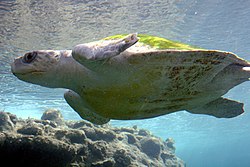| Part of a series on the |
| Wildlife of Great Britain |
|---|
 |
The reptiles of Great Britain include three native snakes and three native lizards. A number of sea turtles visit Great Britain's shores. There are also at least seven introduced reptile species.
| Part of a series on the |
| Wildlife of Great Britain |
|---|
 |
The reptiles of Great Britain include three native snakes and three native lizards. A number of sea turtles visit Great Britain's shores. There are also at least seven introduced reptile species.
| Image | Name | Head (dorsal) | Head (lateral) | Distribution |
|---|---|---|---|---|
 | Common adder (Vipera berus) [1] |  |  |  |
 | Barred grass snake (Natrix helvetica) [2] [a] |  |  |  |
 | Smooth snake (Coronella austriaca) [4] |  |  |  |
| Image | Name | Distribution |
|---|---|---|
 | Slow worm (Anguis fragilis) [5] [6] |  |
 | Viviparous lizard (Zootoca vivipara) [7] |  |
 | Sand lizard (Lacerta agilis) |  |
|}
| Image | Name | Distribution | |
|---|---|---|---|
 | Leatherback sea turtle (Dermochelys coriacea) |  | Foraging [8] |
 | Loggerhead sea turtle (Caretta caretta) |  | Vagrant [9] |
 | Green sea turtle (Chelonia mydas) |  | Vagrant [10] |
 | Hawksbill sea turtle (Eretmochelys imbricata) |  | Vagrant [10] |
 | Kemp's ridley sea turtle (Lepidochelys kempii) |  | Vagrant [10] |
 | Olive ridley sea turtle (Lepidochelys olivacea) |  | Vagrant [11] |
| Image | Name | Distribution | |
|---|---|---|---|
 | European pond turtle (Emys orbicularis) |  | Extirpated - currently extinct in Britain but the rewilding organisation, Celtic Rewilding, aims to reintroduce them by 2026. [12] |
{{cite journal}}: CS1 maint: multiple names: authors list (link)